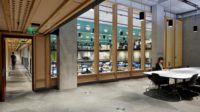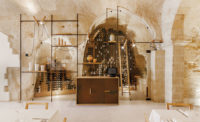There is no aesthetic signature to the diverse buildings produced by Studio Farris since its formation in Antwerp, Belgium, in 2008. They range from a renovated farmhouse with a quietly subversive relationship between new glass and rustic brick to an intentionally iconic “woven” tower proposed for Dubai. What connects them, suggests founder Giuseppe Farris, 43, is not a house style but its opposite—a pragmatic approach that eschews preconceptions and proceeds from the critical interrogation of a brief.
It was this propensity to question that guided Farris’s path to Antwerp from his home on the Italian island of Sardinia. He studied first in Venice, under Aldo Rossi and Manfredo Tafuri, before moving abroad in search of alternatives to Italy’s architectural conservatism. In London he shadowed a friend at the experimentally inclined Architectural Association, though he did not formally enroll. “Super Dutch” architecture was then grabbing international attention, and Farris headed to the Netherlands and neighboring Belgium in 2001 to take advantage of “a very energetic moment in those countries when every studio was looking for new people and ideas.”
The opportunity to establish his own office came with a commission to design a house for a friend, and another for the farmhouse. But it was Belgium’s well-run competition system that gave an outsider the chance to make public buildings. His first success was a project to redesign the entrance hall of the Flemish parliament. Farris’s proposal challenged assumptions inherent in the brief, setting the pattern for subsequent projects. The requirement to accommodate a space-hungry mix of activities threatened to compromise appreciation of the historic interior, so Farris proposed a lightweight two-story pavilion at one end of the room, within which multifunctional spaces support the heterogeneous program. Its formal and material language derives from the architecture of the hall, drawing attention to its surroundings as well as itself.
Reconciling a respect for context with the desire to give an intervention its own character was also a central preoccupation in the extension of a public library in Bruges. While the low-rise addition is formally subordinate, its rusty steel cladding contrasts with the white plaster of the historic building, introducing a deliberate “tension” between the two. This feeling for the particularities of place has deep roots. “It is my cultural baggage,” Farris explains. “Every Italian architect is born in a place with a lot of history, where you have to be careful of the consequences in adding the new to the old.” But his work is refined by “the critical ability that you gain by working outside the culture in which you were born.”
Developing an international perspective was one of Farris’s aims in establishing his practice. The studio is beginning to work overseas and is pushing into new professional territories, as in a project for a radio station that encompasses the design of its furniture and graphic identity. Looking more broadly, Farris says, “We want to make buildings that can improve the quality of the city, and of life.”
















Post a comment to this article
Report Abusive Comment